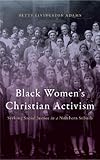Black Women’s Christian Activism : Seeking Social Justice in a Northern Suburb / Betty Livingston Adams.
Material type: Computer filePublisher: New York, NY : New York University Press, [2016]Copyright date: ©2016Description: 1 online resourceContent type:
Computer filePublisher: New York, NY : New York University Press, [2016]Copyright date: ©2016Description: 1 online resourceContent type: - 9781479880324
- African American women civil rights workers -- New Jersey -- Summit -- History -- 20th century
- African American women in church work -- New Jersey -- Summit
- African American women -- Religious life -- New Jersey -- Summit
- Church and social problems -- New Jersey -- Summit
- RELIGION / Christian Life / General
- 277.49/36082082 23
- BR563.B53 A33 2016eb
- online - DeGruyter
| Item type | Current library | Call number | URL | Status | Notes | Barcode | |
|---|---|---|---|---|---|---|---|
 eBook
eBook
|
Biblioteca "Angelicum" Pont. Univ. S.Tommaso d'Aquino Nuvola online | online - DeGruyter (Browse shelf(Opens below)) | Online access | Not for loan (Accesso limitato) | Accesso per gli utenti autorizzati / Access for authorized users | (dgr)9781479880324 |
Browsing Biblioteca "Angelicum" Pont. Univ. S.Tommaso d'Aquino shelves, Shelving location: Nuvola online Close shelf browser (Hides shelf browser)

|

|

|

|

|

|

|
||
| online - DeGruyter The Public Professor : How to Use Your Research to Change the World / | online - DeGruyter The Trans Generation : How Trans Kids (and Their Parents) are Creating a Gender Revolution / | online - DeGruyter The Crisis of Connection : Roots, Consequences, and Solutions / | online - DeGruyter Black Women’s Christian Activism : Seeking Social Justice in a Northern Suburb / | online - DeGruyter Constructing Black Selves : Caribbean American Narratives and the Second Generation / | online - DeGruyter Lifted : A Cultural History of the Elevator / | online - DeGruyter White Kids : Growing Up with Privilege in a Racially Divided America / |
restricted access online access with authorization star
http://purl.org/coar/access_right/c_16ec
2017 Wilbur Non-Fiction Award RecipientWinner of the 2018 Author's Award in scholarly non-fiction, presented by the New Jersey Studies Academic Alliance Winner, 2020 Kornitzer Book Prize, given by Drew UniversityExamines the oft overlooked role of non-elite black women in the growth of northern suburbs and American Protestantism in the first half of the twentieth centuryWhen a domestic servant named Violet Johnson moved to the affluent white suburb of Summit, New Jersey in 1897, she became one of just barely a hundred black residents in the town of six thousand. In this avowedly liberal Protestant community, the very definition of “the suburbs” depended on observance of unmarked and fluctuating race and class barriers. But Johnson did not intend to accept the status quo. Establishing a Baptist church a year later, a seemingly moderate act that would have implications far beyond weekly worship, Johnson challenged assumptions of gender and race, advocating for a politics of civic righteousness that would grant African Americans an equal place in a Christian nation. Johnson’s story is powerful, but she was just one among the many working-class activists integral to the budding days of the civil rights movement.Focusing on the strategies and organizational models church women employed in the fight for social justice, Adams tracks the intersections of politics and religion, race and gender, and place and space in a New York City suburb, a local example that offers new insights on northern racial oppression and civil rights protest. As this book makes clear, religion made a key difference in the lives and activism of ordinary black women who lived, worked, and worshiped on the margin during this tumultuous time.
Mode of access: Internet via World Wide Web.
In English.
Description based on online resource; title from PDF title page (publisher's Web site, viewed 26. Mrz 2024)


